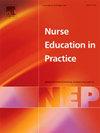Development and validation of a self-assessment instrument for clinical educator competencies in nursing
IF 3.3
3区 医学
Q1 NURSING
引用次数: 0
Abstract
Aim
This study aimed to design and psychometrically evaluate a self-assessment instrument for clinical educator competencies in nursing.
Background
The clinical educator competencies of nursing instructors had a significant impact on the quality of nursing education. However, no comprehensive instrument exists to measure this competence across multiple dimensions.
Design
A methodological study was conducted in two stages: instrument development and psychometric evaluation.
Methods
This study was conducted in two stages from January 2022 to December 2023. In the first stage, a questionnaire was developed based on six dimensions: education, management, communication skills, ethical, personal and psychological competence. Content validity was assessed using expert evaluations and exploratory factor analysis (EFA) was performed to confirm construct validity. Reliability was evaluated using test-retest and internal consistency methods.
Results
The final instrument consisted of 58 items across six dimensions. EFA confirmed five factors with eigenvalues greater than one, explaining 67.96 % of the total variance. The Kaiser-Meyer-Olkin (KMO) value was 0.825 and Bartlett's test was significant (p < 0.001). Reliability tests showed high internal consistency (α=0.967) and stability (correlation coefficient = 0.793).
Conclusions
The developed instrument demonstrated strong validity and reliability, making it suitable for assessing clinical educator competencies in nursing based on Waltz’s four-step approach and the theory of planned behavior.
临床教育工作者护理能力自我评估工具的开发与验证
目的设计一套护理临床教育工作者能力自评工具,并对其进行心理计量学评价。背景护理指导员的临床教育能力对护理教育质量有显著影响。然而,目前还没有一种综合的工具可以跨多个维度测量这种能力。设计方法学研究分两个阶段进行:工具开发和心理测量评估。方法本研究于2022年1月至2023年12月分两个阶段进行。在第一阶段,根据教育、管理、沟通技巧、道德、个人和心理能力六个方面编制问卷。采用专家评价法评估内容效度,并采用探索性因子分析(EFA)确定结构效度。采用重测法和内部一致性法评估信度。结果最终量表包括6个维度的58个项目。EFA确认了5个特征值大于1的因素,解释了67.96 %的总方差。Kaiser-Meyer-Olkin (KMO)值为0.825,Bartlett检验具有显著性(p <; 0.001)。信度检验显示具有较高的内部一致性(α=0.967)和稳定性(相关系数= 0.793)。结论本量表具有较强的信度和效度,适用于基于华尔兹四步法和计划行为理论的临床护理教育者能力评估。
本文章由计算机程序翻译,如有差异,请以英文原文为准。
求助全文
约1分钟内获得全文
求助全文
来源期刊

Nurse Education in Practice
NURSING-
CiteScore
5.40
自引率
9.40%
发文量
180
审稿时长
51 days
期刊介绍:
Nurse Education in Practice enables lecturers and practitioners to both share and disseminate evidence that demonstrates the actual practice of education as it is experienced in the realities of their respective work environments. It is supportive of new authors and will be at the forefront in publishing individual and collaborative papers that demonstrate the link between education and practice.
 求助内容:
求助内容: 应助结果提醒方式:
应助结果提醒方式:


